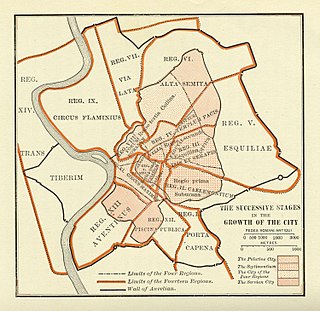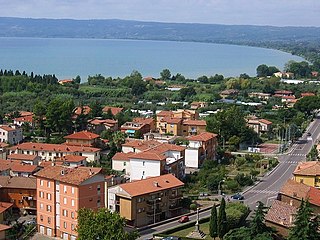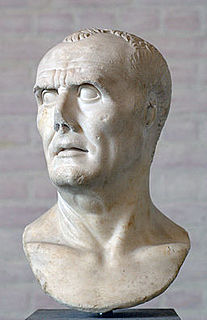Related Research Articles

Lucius Tarquinius Priscus, or Tarquin the Elder, was the legendary fifth king of Rome and first of its Etruscan dynasty. He reigned from 616 to 579 BC. Tarquinius expanded Roman power through military conquest and grand architectural constructions. His wife was the prophet Tanaquil.

The Roman Republic, officially the Senate and People of Rome, was a state of the classical Roman civilization, run through public representation of the Roman people. Beginning with the overthrow of the Roman Kingdom and ending in 27 BC with the establishment of the Roman Empire, Rome's control rapidly expanded during this period—from the city's immediate surroundings to hegemony over the entire Mediterranean world.

The Roman Kingdom, also referred to as the Roman monarchy, or the regal period of ancient Rome, was the earliest period of Roman history, when the city and its territory were ruled by kings.
The Roman legion was the largest military unit of the Roman army, composed of 4,200 infantry and 300 equites (cavalry) in the period of the Roman Republic ; and was composed of 5,200 infantry and 120 auxilia in the period of the Roman Empire.

Servius Tullius was the legendary sixth king of Rome, and the second of its Etruscan dynasty. He reigned from 578 to 535 BC. Roman and Greek sources describe his servile origins and later marriage to a daughter of Lucius Tarquinius Priscus, Rome's first Etruscan king, who was assassinated in 579 BC. The constitutional basis for his accession is unclear; he is variously described as the first Roman king to accede without election by the Senate, having gained the throne by popular and royal support; and as the first to be elected by the Senate alone, with support of the reigning queen but without recourse to a popular vote.

Veii was an important ancient Etruscan city situated on the southern limits of Etruria and only 16 km (9.9 mi) north-northwest of Rome, Italy. It now lies in Isola Farnese, in the comune of Rome. Many other sites associated with and in the city-state of Veii are in Formello, immediately to the north. Formello is named after the drainage channels that were first created by the Veians.
The equites constituted the second of the property-based classes of ancient Rome, ranking below the senatorial class. A member of the equestrian order was known as an eques.

In historiography, ancient Rome is Roman civilization from the founding of the Italian city of Rome in the 8th century BC to the collapse of the Western Roman Empire in the 5th century AD, encompassing the Roman Kingdom, Roman Republic and Roman Empire until the fall of the western empire. The civilisation began as an Italic settlement in the Italian Peninsula, traditionally dated to 753 BC, that grew into the city of Rome and which subsequently gave its name to the empire over which it ruled and to the widespread civilisation the empire developed. The civilization was led and ruled by the Romans, alternately considered an ethnic group or a nationality. The Roman Empire expanded to become one of the largest empires in the ancient world, still ruled from the city, with an estimated 50 to 90 million inhabitants and covering 5 million square kilometres at its height in AD 117.

The Roman army was the armed forces deployed by the Romans throughout the duration of Ancient Rome, from the Roman Kingdom to the Roman Republic and the Roman Empire, and its medieval continuation, the Eastern Roman Empire. It is thus a term that may span approximately 2,205 years, during which the Roman armed forces underwent numerous permutations in composition, organisation, equipment and tactics, while conserving a core of lasting traditions.

Volsinii or Vulsinii, is the name of two ancient cities of Etruria, one situated on the shore of Lacus Volsiniensis, and the other on the Via Clodia, between Clusium (Chiusi) and Forum Cassii (Vetralla). The latter was Etruscan and was destroyed by the Romans in 264 BC following an attempted revolt by its slaves, while the former was founded by the Romans using the remainder of the Etruscan population rescued from the razed city.

The Marian reforms were reforms of the ancient Roman army implemented in 107 BC by the statesman Gaius Marius, for whom they were later named. The reforms originated as a reaction to the military and logistical stagnation of the Roman Republic in the late 2nd century BC. Centuries of military campaigning throughout the Mediterranean and increasing invasions and uprisings across Roman territory had stretched the human and physical resources of the Roman army.
Demaratus, frequently called Demaratus of Corinth, was the father of Lucius Tarquinius Priscus, the fifth King of Rome, and the grandfather or great-grandfather of Lucius Tarquinius Superbus, the seventh and last Roman king.

Social class in ancient Rome was hierarchical, with multiple and overlapping social hierarchies. An individual's relative position in one might be higher or lower than in another, which complicated the social composition of Rome.
The city of Rome, founded in a strategic location among a war-like people, needed to concern itself with military activity from the start. As Rome grew, its military needs changed. This article covers the military establishment of the Roman kingdom up to about 300BC.
The structural history of the Roman military concerns the major transformations in the organization and constitution of ancient Rome's armed forces, "the most effective and long-lived military institution known to history." From its origins around 800 BC to its final dissolution in AD 476 with the demise of the Western Roman Empire, Rome's military organization underwent substantial structural change. At the highest level of structure, the forces were split into the Roman army and the Roman navy, although these two branches were less distinct than in many modern national defense forces. Within the top levels of both army and navy, structural changes occurred as a result of both positive military reform and organic structural evolution. These changes can be divided into four distinct phases.

The socii or foederati were confederates of Rome and formed one of the three legal denominations in Roman Italy (Italia) along with the Roman citizens (Cives) and the Latini. The Latini, who were simultaneously special confederates and semi-citizens, should not be equated with the homonymous Italic people of which Rome was part. This tripartite organisation lasted from the Roman expansion in Italy to the Social War, when all peninsular inhabitants were awarded Roman citizenship.
The Early Roman army was deployed by ancient Rome during its Regal Era and into the early Republic around 300 BC, when the so-called "Polybian" or manipular legion was introduced.

The Roman army of the mid-Republic, also called the manipular Roman army or the Polybian army, refers to the armed forces deployed by the mid-Roman Republic, from the end of the Samnite Wars to the end of the Social War. The first phase of this army, in its manipular structure, is described in detail in the Histories of the ancient Greek historian Polybius, writing before 146 BC.

The Roman expansion in Italy covers a series of conflicts in which Rome grew from being a small Italian city-state to be the ruler of the Italian peninsula. Roman tradition attributes to the Roman kings the first war against the Sabines and the first conquests around the Alban Hills and down to the coast of Latium. The birth of the Roman Republic after the overthrow of the Etruscan monarch of Rome in 509 BC began a series of major wars between the Romans and the Etruscans. In 390 BC, Gauls from the north of Italy sacked Rome. In the second half of the 4th century BC Rome clashed repeatedly with the Samnites, a powerful tribal coalition of the Apennine region. By the end of these wars, Rome had become the most powerful state in central Italy and began to expand to the north and to the south. The last threat to Roman hegemony came during the Pyrrhic war when Tarentum enlisted the aid of the Greek king Pyrrhus of Epirus to campaign in the South of Italy. Resistance in Etruria was finally crushed in 265-264 BC, the same year the First Punic War began and brought Roman forces outside of the peninsula for the first time.

The Servian constitution is the military and political organization of ancient Rome attributed by Roman tradition to the semi-legendary sixth king of Rome, Servius Tullius. Most of the Servian reforms extended voting rights to certain groups, in particular to Rome's citizen-commoners who were minor landholders or landless citizens hitherto disqualified from voting by ancestry, status or ethnicity—collectively, the plebs as distinguished from the hereditary patricians. These reforms thus redefined the fiscal and military obligations of all Roman citizens. The so-called Servian constitution probably represents a long-drawn, complex and piecemeal process extending from Servius' predecessors, Ancus Marcius and Tarquinius Priscus, to his successor Tarquinius Superbus, and into the Middle and Late Republic. Rome's military and territorial expansion and the consequent changes in its population made franchise regulation and reform an ongoing necessity. The wholesale attribution of these measures to Servius "cannot be taken at face value".
References
- ↑ Adsiduus in Charlton T. Lewis, An Elementary Latin Dictionary
- ↑ Livy, History of Rome, Book I, chapter 42 Archived October 2, 2009, at the Wayback Machine and Book I, chapter 43
- ↑ Connolly, Peter, Greece and Rome at War, pp95-96.
- ↑ Connolly, Peter, Greece and Rome at War, p95.
- ↑ Connolly, Peter, Greece and Rome at War, p214.
- ↑ Rich, The supposed manpower shortage